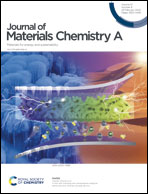Fabrication of impermeable dense architecture containing covalently stitched graphene oxide/boron nitride hybrid nanofiller reinforced semi-interpenetrating network for hydrogen gas barrier applications†
Abstract
Concerning the issues of compressed hydrogen (H2) storage, we have developed a novel H2 gas barrier coating containing a dense network structure of thermoplastic polyurethane (TPU)/epoxy semi-interpenetrating network (S-IPN) reinforced with a graphene oxide (GO)/h-boron nitride (BN) hybrid nanofiller (f-GO-BN) for nylon 6 based pressure vessels. A new strategy was adopted to synthesize f-GO-BN by first reacting the aminosilane with GO in the presence of carbodiimide followed by the addition of BN, instead of following the reverse order as reported earlier. The new method manifested homogeneous distribution of BN on the GO surface with higher grafting efficiency, as well as partial reduction of GO, which ultimately exhibited a synergistic effect in mechanical properties when the hybrid nanofiller was dispersed in the S-IPN. The long tortuous path provided by f-GO-BN in conjunction with the dense crosslinked network of the S-IPN as formed after the spray coating drastically reduced the H2 transmission rate (H2GTR) at 25 °C, and at elevated temperature (50 °C). The 10 wt% f-GO-BN filled S-IPN containing 40 wt% epoxy exhibited a 97% reduction of H2GTR at 25 °C and the permeability coefficient was extremely low (0.006 cm3 mm m−2 d−1 atm−1). Moreover, f-GO-BN improved the thermal conductivity and water contact angle, and minimized the thermal expansion of the coated layer. The epoxy chains of the S-IPN and the grafted aminosilane delineated a strong adhesion with nylon 6 at ambient, as well as cryogenic temperatures, ensuring the long-term applicability of the barrier coating.



 Please wait while we load your content...
Please wait while we load your content...